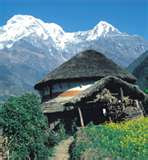Khokana, the medieval village of the Newar community, the indigenous community of the Kathmandu Valley, is situated at about 5-6 km southwest part of Lalitpur. It has a s

teep slope towards west whereas the main settlement is located on the elevated land with plain land or slopes virtually separated physically for agriculture. The total population of Khokana is about 4542. 97.7% are inhabitants from Newar community and others are Thakuri, Tamang, Chhetri, Sunuwar, Bhote etc. Khokana has long been famous as an oil-pressing center where mustard seeds are pressed using traditional wooden beams. Mustard oil pressed by traditional wooden beams makes the famous Newari food ‘chhoyela’ delicious and adds real traditional flavour.
How to reach
Khokana is easily accessible by road. To reach this village one has to follow the straight road from the Tibetan refugee camp at Jawalakhel. There are many buses which arrive in 30 minutes interval to Khokana.
When to visit
The best time to visit Khokana is during October and November. During this time several festivals are held here. Shrikali Jatra, Kartik Jatra falls in October. At that time the whole village looks colorful as the villagers hang red chilly garland from the top floor to the ground floor. Most of the farmers of this village are either involved in spinning or oil-pressing business.
Major attractions
Khokana is a settlement with a very dense urban character in a scenic and peaceful environment. The village still retains its original urban, fabric and architecture along with its typical Newar atmosphere and traditional lifestyle. The rich heritage and relatively unchanging life style of the Newar people is clear to see in Khokana. The village is rich in both natural and man-made attractions. The medieval old houses, the alleys and streets, temples, traditional practices and festivals that go throughout the year are the attractions of this unexplored land. There are many small villages at Khokana and these villages give the feeling of going back to the medieval period since people still follow the ancient way of life and their brick houses are unchanged from ages past. The most unique to see in this village is the weaving of red chilies, giving it a look of chilly garland. The houses in Khokana are built in typical Newari style with impressive carved windows, all stereotyped, standing three storied from the ground with a sloped roof of Nepalese roof tiles.
The three storied temple of Rudrayani situated at the center of the settlement and Shrikali temple at west side of the settlement are the main monuments that show the rich art and architecture of Khokana. The major festivals observed falls in Kartik when the chariot procession of goddess Rudrayani takes place. The other festivals such as Baisakh Sankranti, Indrajatra, Sithi-Nakha:, Janai Purnima, De-Pukhu Jatra, Saparu Swanti and Dhaya Purnima are also celebrated in Khokana.Chwe-Lachhi (the main courtyard at the center of Khokana village), Kwe-Lachhi (to the west of main Lachhi), Hyabu-Lachhi ( North west of core area of Khokana settlement), Gaabu-Lachhi (North west of Chwe-Lachhi), Chi-Khokana, Kudesh (the oldest settlement area of Khokana ), Shikali Khyo (a plain area where the Shrikali temple is situated) are some of the important places not to be missed while visiting Khokana. The Khokana VDC has eight major water bodies or Pukhus (Khaa, Palla, Dev, Gaa, Kutu, Bakha, Fonga and Chokhana ponds) which are also considered as one of the attractions of Khokana. The typical Newari settlements, traditional houses, temples, monuments, patis, water bodies, squares, cultural practices, events like Jatras/Festivals, rituals, lifestyle have made this place a living museum which could be of great interest for both domestic and international tourists.
Facilities and Amenities
Bungamati police station looks after the security of Khokana. However, the local people feel quite secure as they are living in their own close community. There are 29 private telephone line connections and 2 public telephone line connections in whole Khokana VDC. The postal services are also available right in the VDC office. Other facilities available are simple hotels, tea shops, retail shops, cloth shops, electric shops, dispensary, tailoring, handicrafts, communication or STD/ISD, audio video shops, screen printing shops etc.






